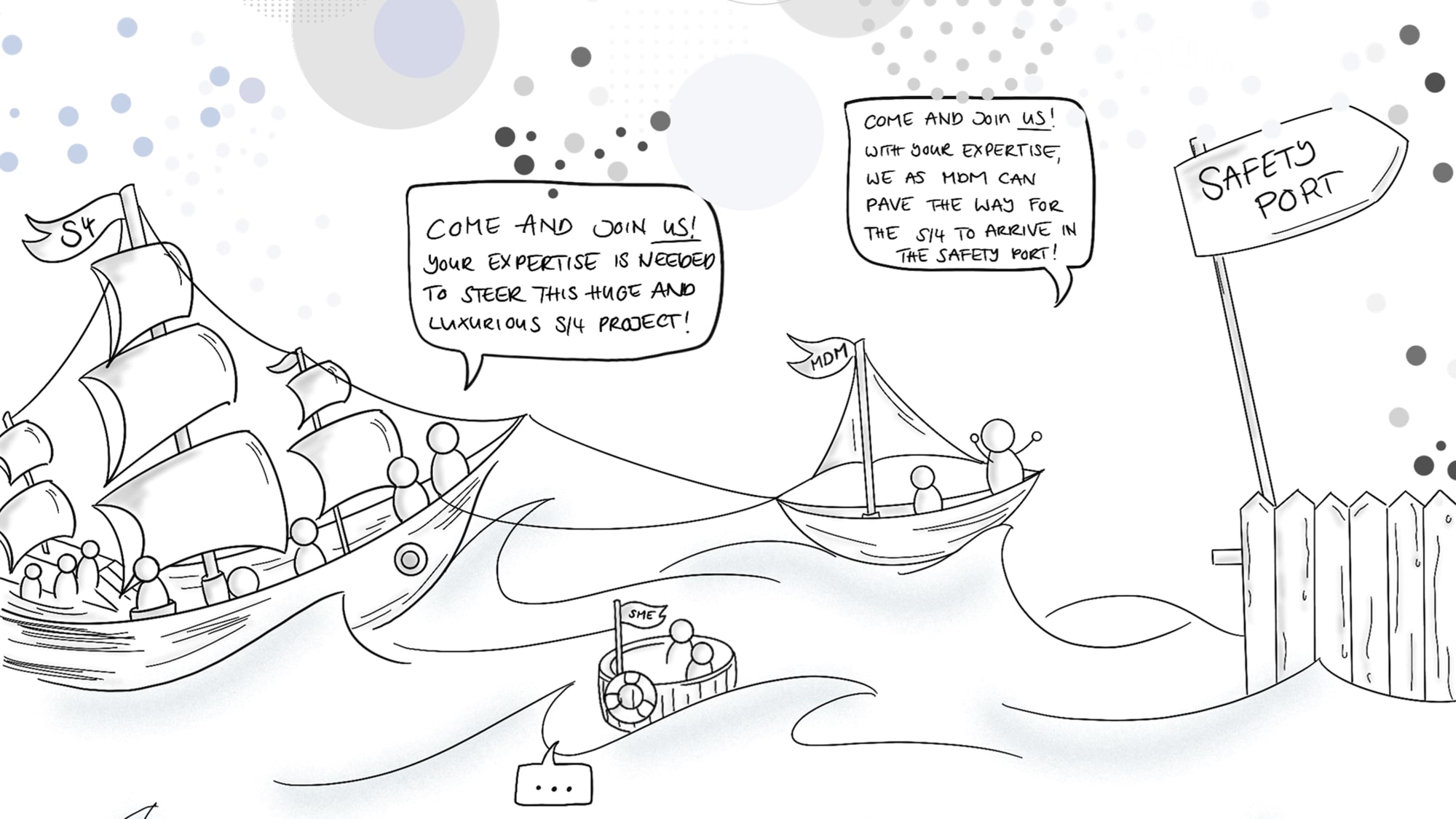
AI-Driven Application & Process Testing: Embracing Agentic Testing
Learn how Agentic AI enables digital transformation, delivering true hyperautomation.

Introducing SAP MDG next to an S/4HANA transformation project? This leads to many challenges, such as a lack of appreciation for MDM, a lack of requirements and a lack of resources. But there is hope. A number of mitigations help to pave the way for a smooth ride towards introducing SAP MDG.

In the light of data becoming more and more important for today’s businesses, many companies are confronted with the question whether to introduce data governance, and in line with this: master data management. Most of those who decide positively go for a dedicated tool to support their master data management. For companies already focusing on SAP software, the SAP MDG module is usually in the pool of options.
In the last years, this often resulted in the same scenario: Introducing SAP MDG next to a huge S/4HANA transformation project, struggling for the right level of attention and resource concessions. And this is where we start our article.
Our example company has decided to introduce SAP MDG. They enthusiastically start an implementation project. Members of the data department (if such already exists, otherwise new job descriptions are put in place) develop a vision and a roadmap, decide on resource needs, and often hire a consulting firm to support the implementation with their experience. They begin with a grand kick-off, sail through the as-is analysis and structure their approach to formulate requirements for the future design. This is where the big sister project – S/4HANA – enters the scene. Latest at this point, reality kicks in. The MDM project members face numerous challenges, in a company which is in the midst of a fundamental technical and organizational transformation. So how to continue?
In this article, we will collect and introduce these challenges. Not to be too pessimistic, we will then move on to mitigation approaches to finish with a great opportunity of the described set-up.
There are various master data objects: the business partner master (customers and suppliers), the material master, the finance master, the enterprise asset master and many more. Furthermore, there are customizing objects which are used within the master data, such as plants, sales organizations and material groups. Members of the line organization, who work with these objects on a daily basis, know the different objects and how to distinguish between them. However, the managers and seniors responsible for the S/4HANA project rarely work with these objects, and so they have a hard time to differentiate the various objects. The fact that the SAP terms for the master data objects usually deviate from those used within a company hampers the understanding further. Last, the acknowledgement of master data is still ambiguous in many companies. Hence, master data is often forgotten during the planning of an S/4HANA transformation project, which brings us to the second challenge.
The main purpose of master data is to enable business processes. For example, a company needs client data and product/material data to place a sales order. Therefore, business process managers are the ones who have the requirements for master data objects. However, often, process managers are not aware of their needs as the have never analyzed which of their business processes requires which master data. There are no methodologies at hand to derive requirements out of business processes. Furthermore, even if requirements are pronounced, many times their level of detail does not match the needs of an MDG design. Last, we want to mention the importance of coordination. Depending on the project set-up it is vital and often missed to extend the right requirements to right target audience (e.g., migration relevant information have to reach the migration team which can be part of the S/4HANA project as well as the MDG project).
Finding the right resources and allowing the time for them to participate in project work is another major challenge of MDG projects. Usually, master data is created or enhanced by people who are also responsible for daily business processes. Hence, the same knowledgeable persons are needed for business process designs in the S/4HANA project as well as the elaboration of requirements for the MDG project. As the importance of master data management is regularly underrated, no budget is reserved for MDM and the business process workshops are generally better staffed. In addition, a customary set-up of the S/4HANA project is by end-to-end business processes, meaning a sales process, a purchasing process, or a maintenance process. Resources freed up for participation in the S/4HANA transformation are specialists for each process. There are few representatives with cross-stream knowledge, which is necessary for MDM. Therefore, specialists from each stream are needed to design an overarching MDM concept, however, they lack timely capacity to cover all the project needs of S/4HANA and MDG. The last resource challenge mainly concerns bigger companies. The gap between the people deciding in an S/4HANA project and those working in the line organization is large, thus, identifying those knowledgeable in MDM is complex.
Let us come to the positive part of the article. There are things one can do to alleviate the challenges above.
The first thing to do, either in a MDG project next to an S/4HANA project or in a solitary project, is to build up a stable business case. This means, having the facts and figures about savings at hand, and finding a sponsor in your organization who has an influential position and can back you up during times of doubt. Next, translate the SAP data objects into your company’s terms, so you speak the same language as your colleagues.
Once you have the sponsor and the shared understanding, try to spread the news of your planned SAP MDG project. Find opportunities to show the relevant leads in the S/4HANA project (e.g. logistics lead, purchasing lead) what master data is, including examples from their team’s daily business. Make sure, they are aware of your endeavors, so they are not taken by surprise once you ask for resources. Additionally, find opportunities to go into the line organization and demonstrate your project vision to end users. This way, you have a chance of finding the right experts for your project. Once their team leads and the experts themselves have recognized the advantages your project will have for them, you are more likely to find their support and participation during your project. These mitigations relieve the challenge of spreading the understanding of master data and finding the right resources.
For more methodological challenges, such as process analysis, data model derivations or agile project management, it is easy to seek help from a consulting company. They can support by applying structured approaches to derive requirements and transfer them to the teams who need them. We at Camelot have met these challenges many times and have developed best practices for master data requirements in business processes. Equipped with these templates, we then move on to a set of workshops to adapt the template requirements to your specific needs. Thereby, we can facilitate a smooth MDG design phase.
The last, more drastic idea to cope with the challenges of the two projects is by letting the MDM project precede the S/4HANA project. (This is, of course, only possible, in case your S/4HANA transformation has not yet begun.) The advantage of the approach is that taking up requirements just for master data as well as data cleansing, can be moved up while members of the line organization are not yet fully engaged in the S/4HANA transformation. Data objects which are transformed from the SAP R3 version to S/4HANA such as the business partner or certain finance objects, can be transformed in advance, so you start S/4HANA on a clean slate. Once the S/4HANA transformation starts, you only have to do a fit-gap analysis which requires less resources.
The challenges many of us face jumping into an SAP MDG implementation next to our big sister – a S/4HANA transformation – can be overwhelming. Yet, there are many ideas for a company to cope with these. So, grab as many mitigation approaches as possible and frame your project as smooth as possible. And focus on the bright side: Most S/4HANA projects thrive to harmonize and standardize processes and design them as close to the SAP standard as possible. Benefit from these aspirations. Use the standardization of business processes to introduce standardized and harmonized data. Once accomplished, those who felt the pain of bad data (in lost profits or daily technical issues) will appreciate your efforts.

Learn how Agentic AI enables digital transformation, delivering true hyperautomation.

Reimagine resilience and proactively minimize supply chain risks

This article shall help you to understand how to optimize your inventory positions in a month – or even less.

Modern PLM systems empower businesses to achieve product excellence in fast-paced markets by enhancing collaboration, agility and innovation.
© Camelot Management Consultants, Part of Accenture
Camelot Management Consultants is the brand name through which the member firms Camelot Management Consultants GmbH, Camelot ITLab GmbH and their local subsidiaries operate and deliver their services.